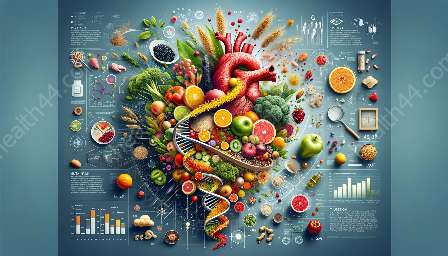Advancements in technology have revolutionized the way we assess and monitor dietary habits, providing innovative solutions to improve nutritional assessment and overall nutrition. This topic cluster will delve into the impact of technology on dietary assessment, monitoring methods and tools, and its compatibility with nutritional assessment and overall nutrition.
1. Technological Advancements in Dietary Assessment
Traditional methods of dietary assessment, such as self-reported food diaries and recalls, are often subject to bias and inaccuracies. However, technology has introduced novel approaches to dietary assessment, such as mobile applications, wearable devices, and image-based analysis tools. These advancements enable individuals to track their dietary intake, monitor nutritional content, and receive real-time feedback on their eating habits.
1.1 Mobile Applications for Dietary Tracking
Mobile applications designed for dietary tracking have gained popularity due to their user-friendly interfaces and comprehensive databases of food items. Users can log their meals, track macronutrient intake, and set personalized dietary goals. Some apps also utilize image recognition technology to estimate portion sizes, further enhancing the accuracy of dietary assessment.
1.2 Wearable Devices for Nutritional Monitoring
Wearable devices, such as smartwatches and fitness trackers, have evolved to include features for monitoring dietary habits. These devices can track caloric expenditure, heart rate variability, and even analyze dietary patterns based on eating behavior and metabolic data. By seamlessly integrating dietary monitoring into everyday activities, wearable devices have simplified the process of assessing nutritional intake.
1.3 Image-Based Analysis Tools
Image-based analysis tools leverage machine learning algorithms to analyze food images and estimate nutritional content. This technology enables users to capture and upload images of their meals, receiving instant feedback on the calorie, macronutrient, and micronutrient composition. By automating the process of dietary analysis, these tools offer a convenient and accurate method for monitoring nutritional intake.
2. Impact on Nutritional Assessment
The intersection of technology and dietary assessment has significantly impacted the field of nutritional assessment, enhancing the accuracy and efficiency of evaluating dietary intake. With real-time data capture and analysis, professionals can gain deeper insights into individuals' nutritional habits, allowing for personalized recommendations and interventions.
2.1 Data-Driven Insights for Nutritionists
Nutritionists and dietitians can leverage technology-driven dietary assessment tools to obtain comprehensive data on their clients' eating behaviors. By analyzing patterns, nutritional deficiencies, and adherence to dietary guidelines, professionals can tailor dietary interventions to meet specific nutritional needs. The availability of detailed dietary data equips practitioners with evidence-based insights to guide their clients towards optimal nutritional outcomes.
2.2 Research Advancements in Nutritional Epidemiology
Technology-enabled dietary assessment methods have also transformed the landscape of nutritional epidemiology. Large-scale studies can now utilize digital platforms to collect dietary data from diverse populations, facilitating the analysis of dietary patterns, nutrient intake, and health outcomes. This wealth of data supports epidemiological research and contributes to a broader understanding of the impact of diet on public health.
3. Compatibility with Nutritional Assessment and Overall Nutrition
The integration of technology into dietary assessment and monitoring aligns with the goals of nutritional assessment and overall nutrition, as it fosters a holistic approach to understanding and managing dietary habits. Whether used by individuals, nutrition professionals, or researchers, these technological advancements offer the potential to revolutionize the way we perceive and engage with nutrition.
3.1 Personalized Nutrition Guidance
By harnessing technology for dietary assessment and monitoring, personalized nutrition guidance becomes increasingly accessible. Individuals can receive tailored recommendations based on their dietary preferences, nutritional needs, and health goals. Whether through interactive apps or wearable devices, personalized nutrition guidance supports individuals in making informed choices that align with their overall nutritional well-being.
3.2 Enhanced Nutritional Education and Awareness
Technology-driven dietary assessment tools contribute to enhanced nutritional education and awareness among the general population. Utilizing interactive platforms and visual representations of dietary data, individuals can gain a deeper understanding of the nutritional content of their meals. This heightened awareness fosters informed decision-making and empowers individuals to prioritize nutrition in their daily lives.
3.3 Advancements in Public Health Nutrition
The compatibility of technology for dietary assessment and monitoring with nutritional assessment extends to the realm of public health nutrition. By leveraging digital tools to capture dietary intake at a population level, public health professionals can identify trends, disparities, and areas for intervention. This data-driven approach enhances the design and implementation of nutrition-focused public health initiatives, ultimately contributing to improved overall nutrition within communities.
In conclusion, technology has fundamentally transformed the landscape of dietary assessment and monitoring, offering innovative solutions that align with the principles of nutritional assessment and overall nutrition. From personalized dietary tracking to data-driven insights for nutrition professionals, the integration of technology fosters a holistic approach towards understanding and managing dietary habits. As these advancements continue to evolve, the potential to revolutionize the way we engage with nutrition grows, paving the way for improved nutritional outcomes at both individual and population levels.


